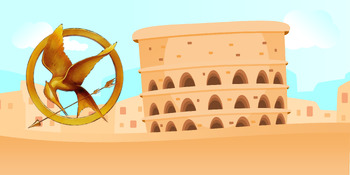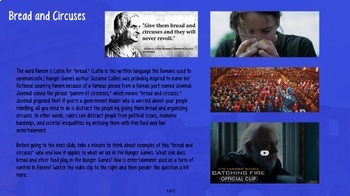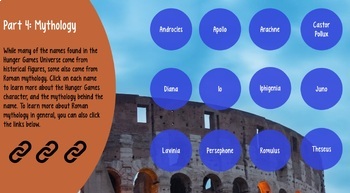The Hunger Games and Ancient Rome
- PDF
- Prezis
Description
▬▬▬▬▬▬ SUMMARY ▬▬▬▬▬▬
This course explores the four books of the Hunger Games series (including the prequel, The Ballad of Songbirds and Snakes) and how the history, culture, and mythology of the Roman Empire inspired the fictional culture of Panem. Students will explore book and movie references from the series that drew inspiration from Roman practices, people, and beliefs. A large number of characters from the Hunger Games (especially the more recent prequel) are named after Roman figures from history and mythology; over half of the course compares and contrasts these Roman figures to their counterparts in the Hunger Games series.
This is not a comprehensive overview of the Hunger Games series or Roman history; its focus is on the overlap between the Hunger Games and Ancient Rome. Learners should have at least read the first book and/or watched the first movie. Keep in mind that there will be spoilers from the other books/movies.
▬▬▬▬▬▬▬ FORMAT ▬▬▬▬▬▬▬
This is a copy of the materials I use as a flex class on Outschool. The Prezi is divided into four parts.
Depending on the abilities of the student, the core course material in each part should take 50-70 minutes to complete; exploring the extension activities (such as links and videos) can provide 1-4 additional hours of content per part, depending on the interest level of the learner.
If you’re using the Prezi in a traditional classroom setting, you might assign 1-2 class periods for each part, depending on whether you want students to simply explore the materials, or dig deeper and take notes, watch the videos, etc.
You can also consider assigning each of the four parts to different groups in the class, and then have those groups do a presentation on what they found most interesting.
If you are using these materials in a regular school setting, you might want to use these materials for reverse instruction or a flipped classroom unit. For instance, you can assign the Prezi to read at home and take notes, and then do a group project in class to share what they’ve learned.
If you are using these materials in a home school setting, you could choose to do one part per day or one part per week. Feel free to have your child email me at lauren.rae.ard@gmail.com, if they have any questions or want to share what they’ve done with the materials.
If you’d like a copy of the Prezi that you can edit to fit your needs, such as changing the assignments, adding point values, instructing students how to answer the questions, adding your own activities, etc., simply email me at lauren.rae.ard@gmail.com and I will make you a customizable copy. You will need to set up a free Prezi account in order to edit the presentation to your liking.
▬▬▬▬▬▬▬ TOPICS COVERED ▬▬▬▬▬▬▬
Part 1: Roman Culture vs. Panem. We compare and contrast Panem to the Roman Empire. For instance, what are the similarities and differences between the Roman Gladiator Games and the Hunger Games? Where did the name "Panem" come from? What references to Roman culture do we find in the Hunger Games series. We'll also begin our exploration of Hunger Games characters named after Roman historical figures (names that start with A through Ca).
Part 2: We'll continue learning about Hunger Games characters named after Roman historical figures with the names that start with Ci through F. We'll explore the meaning and symbolism (or lack thereof) in using Roman names for Hunger Games characters.
Part 3: We'll continue learning about Hunger Games characters named after Roman historical figures with the names that start with G through Z. We'll also watch a few interviews with Suzanne Collins to explore other inspirations she used to create the Hunger Games (besides Ancient Rome).
Part 4: This part is devoted to the 12 Hunger Games characters who were named after (or inspired by) Roman mythology. We'll explore the similarities and differences between the mythical characters of Ancient Rome, and the fictional characters created by Suzanne Collins.





